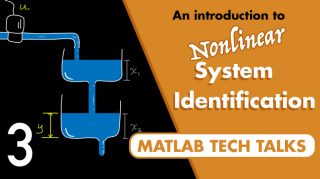System Identification Toolbox 快速入门
System Identification Toolbox™ 提供 MATLAB® 函数、Simulink® 模块,以及用于动态系统建模、时间序列分析和预测的 App。您可以了解测量变量之间的动态关系,以在使用时域或频域数据在连续或离散时间下创建传递函数、过程模型和状态空间模型。您可以使用 AR、ARMA 及其他线性和非线性自回归建模方法来预测时间序列。
本工具箱支持您通过哈默斯坦-维纳模型和非线性 ARX 模型使用机器学习方法(如高斯过程 (GP)、支持向量机 (SVM) 和其他表示法)来估计非线性系统动态特性。您也可以使用深度学习方法创建神经常微分方程 (ODE) 模型来捕获非线性系统动态特性。该工具箱可用于执行灰盒系统辨识以估计用户定义模型的参数。您可以将辨识模型集成到 Simulink 中进行快速仿真,以实现控制设计和诊断以及预后应用。
您可以使用扩展或无迹卡尔曼滤波器和粒子滤波器进行在线参数和状态估计,用于自适应控制、故障检测和软测量应用。该工具箱支持您为在线估计算法生成 C/C++ 代码以部署到嵌入式设备。
教程
- Identify Linear Models Using System Identification App
Identify linear black-box models from single-input/single-output (SISO) data using the System Identification app.
- Identify Linear Models Using the Command Line
Identify linear models from multiple-input/single-output (MISO) data using System Identification Toolbox commands.
- Identify Low-Order Transfer Functions (Process Models) Using System Identification App
Identify continuous-time transfer functions from single-input/single-output (SISO) data using the app.
- Estimate Continuous-Time Grey-Box Model for Heat Diffusion
This example shows how to estimate the heat conductivity and the heat-transfer coefficient of a continuous-time grey-box model for a heated-rod system.
- Identify Nonlinear Black-Box Models Using System Identification App
Identify nonlinear black-box models from single-input/single-output (SISO) data using the System Identification app.
关于系统辨识
- System Identification Overview
System identification is a methodology for building mathematical models of dynamic systems using measurements of the system’s input and output signals.
- 系统辨识工作流
系统辨识工作流程中的典型任务摘要。
- Supported Data
System Identification Toolbox software supports estimation of linear models from both time- and frequency-domain data.
- Supported Continuous- and Discrete-Time Models
Types of continuous-time and discrete-time models you can estimate from time- and frequency-domain data.
- Estimating Models Using Frequency-Domain Data
Overview of frequency-domain identification in the toolbox.
- Working with System Identification App
Working with System Identification App.
- What Is Online Estimation?
Estimate states and parameters of a system in real-time.
视频
系统辨识第 1 部分:系统辨识概述
系统辨识是使用数据(而非物理实体)开发动态系统模型的过程。了解系统辨识以及它在宏观框架内发挥何种作用。
系统辨识第 2 部分:线性系统辨识
了解如何使用系统辨识对受噪声和外部扰动破坏的数据进行线性模型拟合和验证。
系统辨识第 3 部分:非线性系统辨识
通过探索众多可能的模型选项之一(非线性 ARX 模型)了解非线性系统辨识。
系统辨识第 4 部分:在线和递归系统辨识
了解在线系统辨识。这些算法在新的数据被实时或近似实时地测量和获得时估计模型的参数和状态。



